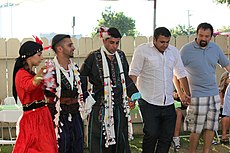Ethnic groups by continent

Africaedit
Ethnic groups in Africa number in the hundreds, each generally having its own language (or dialect of a language) and culture.
Many ethnic groups and nations of Africa qualify, although some groups are of a size larger than a tribal society. These mostly originate with the Sahelian kingdoms of the medieval period, such as that of the Akan, deriving from Bonoman (11th century) then the Kingdom of Ashanti (17th century).
Asiaedit
This section needs additional citations for verification. (January 2013) (Learn how and when to remove this template message) |
Ethnic groups are abundant throughout Asia, with adaptations to the climate zones of Asia, which can be the Arctic, subarctic, temperate, subtropical or tropical. The ethnic groups have adapted to mountains, deserts, grasslands, and forests.
On the coasts of Asia, the ethnic groups have adopted various methods of harvest and transport. Some groups are primarily hunter-gatherers, some practice transhumance (nomadic lifestyle), others have been agrarian/rural for millennia and others becoming industrial/urban. Some groups/countries of Asia are completely urban, such as those in Hong Kong, Shanghai, and Singapore. The colonization of Asia was largely ended in the 20th century, with national drives for independence and self-determination across the continent.
Russia has over 185 recognized ethnic groups besides the 80% ethnic Russian majority. The largest group is the Tatars 3.8%. Many of the smaller groups are found in the Asian part of Russia (see Indigenous peoples of Siberia).
Europeedit
Europe has a large number of ethnic groups; Pan and Pfeil (2004) count 87 distinct "peoples of Europe", of which 33 form the majority population in at least one sovereign state, while the remaining 54 constitute ethnic minorities within every state they inhabit (although they may form local regional majorities within a sub-national entity). The total number of national minority populations in Europe is estimated at 105 million people or 14% of 770 million Europeans.
A number of European countries, including France, and Switzerland do not collect information on the ethnicity of their resident population.
Russia has over 185 recognized ethnic groups besides the 80% ethnic Russian majority. The largest group is the Tatars 3.8%. Many of the smaller groups are found in the Asian part of Russia (see Indigenous peoples of Siberia).
An example of a largely nomadic ethnic group in Europe is the Roma, pejoratively known as Gypsies. They originated from India and speak the Romani language.
Serbian province of Vojvodina is recognizable for its multi-ethnic and multi-cultural identity. There are some 26 ethnic groups in the province, and six languages are in official use by the provincial administration.
North Americaedit
This section is empty. You can help by adding to it. (August 2018) |
South Americaedit
This section is empty. You can help by adding to it. (August 2018) |
Oceaniaedit
Australiaedit
This section is empty. You can help by adding to it. (August 2018) |
Comments
Post a Comment